Lenovo ThinkPad T490s Review
Lenovo ThinkPad T490s Review
Retro style and features hide a thoroughly modern Windows 10 laptop
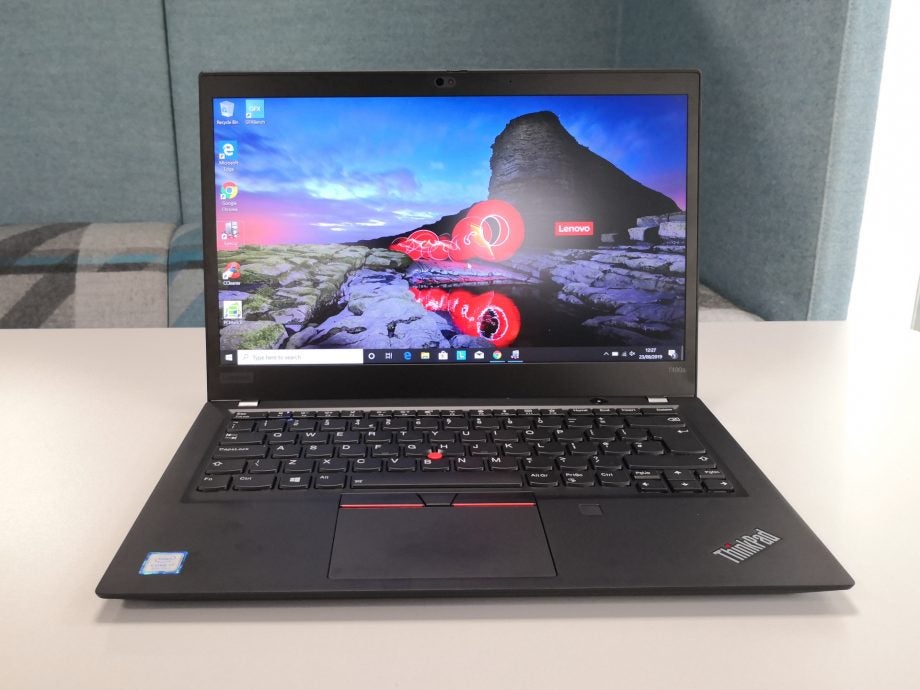
Verdict
The Lenovo ThinkPad T490s means business. Look beyond the defiantly anachronistic stylings and you'll find a solid, reliable machine with security features beyond those of most other consumer-grade devices.
Pros
- Solid construction
- High-quality display
- Good battery life
- Built-in security features
- The classic design hasn’t changed
Cons
- Extension required for Ethernet connection
- The classic design hasn’t changed...
Key Specifications
- 14-inch Full HD display
- Intel Core i5-8265U / i7-8565U / Core i5-8365U / Core i7-8665U
- 128GB / 256GB / 512GB / 1TB
- 8GB / 16GB
- Trackpad with middle-click button
- ThinkPad pointing stick/nub
- Lenovo smart card reader
- 329mm x 226.15mm x 16.7mm
- 1.35kg
- USB-C, USB-C w/ Thunderbolt 3, 2 x USB-A 3.1, HDMI 1.4, microSD/micro-SIM slot, smart card reader, 3.5mm headphone/mic jack
What is the Lenovo ThinkPad T490s?
The Lenovo ThinkPad T490s is the latest in a series of the legendary workhorse laptops aimed at business users.
If you’re about to start a new job then chances are you may find one such unit waiting for you on your desk on your first day. If not, and you’re just after a reliable Windows 10 laptop primarily for office or university work, then read on.
I’m often asked for advice over which laptop should be the next purchase, quickly followed by “I mainly need something for writing and browsing the web, and also Netflix”. While there are plenty of laptops out there that will cater to those needs, and for less than the cost of even the cheapest Lenovo ThinkPad T490s (check out our best budget laptops roundup), few come close to matching the T490s for build quality, versatility or longevity.
The Lenovo ThinkPad T490s is a well-built laptop that’s decidedly unflashy. It means business – and if you do, too, then this may be the laptop you’re looking for.
Related: Best laptops
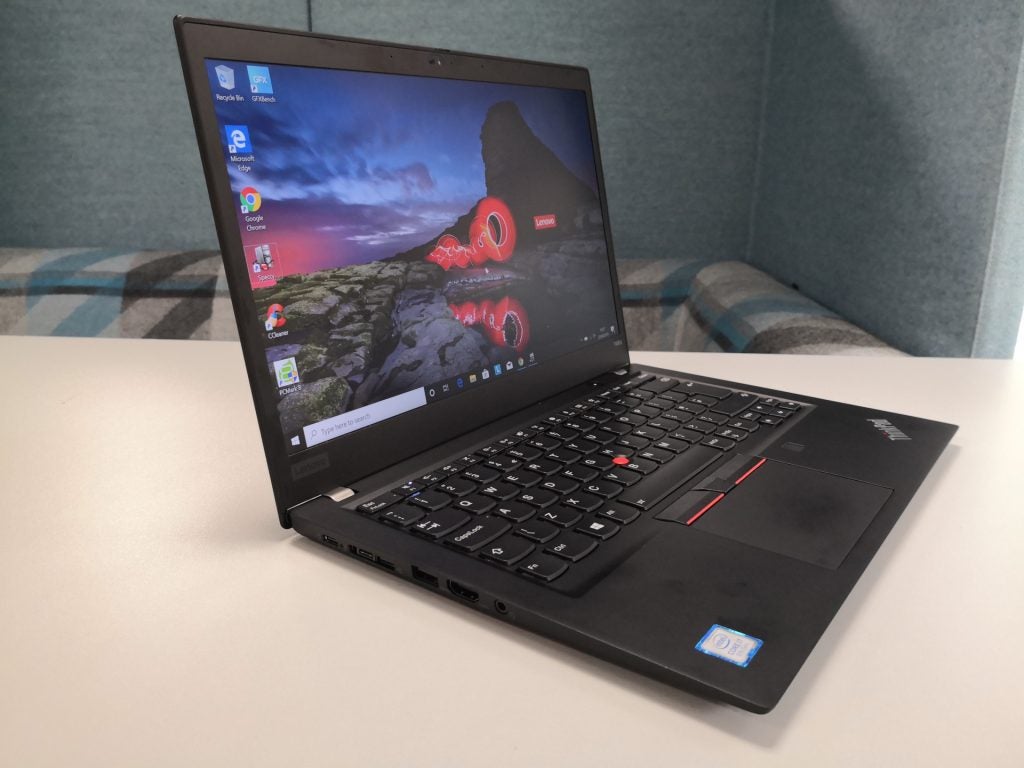
The ThinkPad T490s – a 1999 exterior hides a 2019 interior
Design – The Lenovo ThinkPad T490s looks like a black box recorder
In terms of style, the new T490s does nothing to buck the ThinkPad trend. The boxy black design has remained unchanged. In fact, if you were to place it in a lineup next to a ThinkPad T460s ,T470s, or T480s, you’d really have to squint in order to tell them apart.
The glowing red LED sitting above the dot of the “i” in the ThinkPad logo is present and correct, as is the trackpad with a middle-click button and the pointing stick – the atavistic rubbery nipple that sits between the “G”, “H”, and “B” letter keys.
The differences are mainly found under the hood. You get the option of Intel Core i5 or Core i7 Whiskey Lake processors – which, until Ice Lake and Comet Lake laptops start landing on shelves, is your best option.
Related: Best student laptop
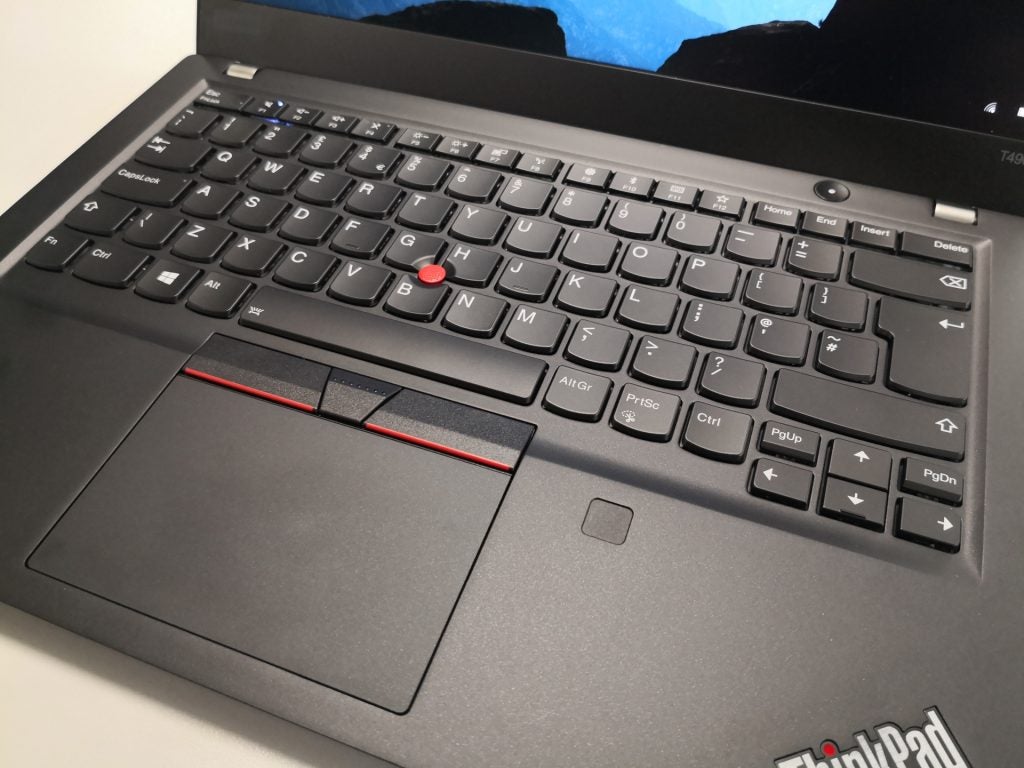
The keys might look old-school, but they make for an excellent typing experience
Size-wise, the ThinkPad T490s is a little smaller than last year’s T480s – 329mm x 226.15mm x 16.7mm vs 331mm x 226.8mm x 18.45mm – but it weighs a slightly heavier 1.35kg.
There are a few security features that make the T490s stand out from your typical lifestyle laptop. As with the T480s, Lenovo has added a fingerprint scanner to the T490s, which is more secure and arguably more convenient than having to enter (and remember) complex PINs and passwords.
There’s also a built-in webcam control that lets you cover the sensor of the 720p webcam for times when you’re not using it.
The model I picked up for review featured a standard LCD panel with IPS (in-plane switching), but Lenovo’s site mentions that you can pick up a ThinkPad T490s with a PrivacyGuard display. This works in a similar way to HP’s SureView anti-snooping tech, seen on laptops such as the HP EliteBook 1050 G1. It narrows the viewing angle of the display, preventing anyone looking over your shoulder or sat next to you from seeing what’s on your screen. It doesn’t look like it’s available to buy at the time of writing, so hopefully Lenovo will re-stock soon.
In terms of ports there’s plenty here: two Type-C USB ports, one supporting Thunderbolt 3, Ethernet, HDMI, a 3.5mm headphone jack, two USB-A ports, and a Kensington lock slot.
Some minor downsides: you’ll need to buy a separate RJ-45 Extension Connector (£15.60) if you want to make use of that Ethernet port, and the HDMI port is 1.4, which caps 4K video at 50fps instead of the more up-to-date HDMI 2.0 standard that supports 4K at up to 60fps.
While there’s no full-sized SD card reader here, there is a microSD slot on the laptop’s rear. The tray pops out, in the same way it would on a phone. You can also fit a SIM card in here, if you wish – although since popping in my regular O2 SIM didn’t do anything, I can’t report on how effective this is.
Finally, there’s a slot for smart cards on the left side, which can be used to encrypt data stored on the hard drive, for example, and to grant your ThinkPad access to your company’s VPN.
Related: Best VPNs
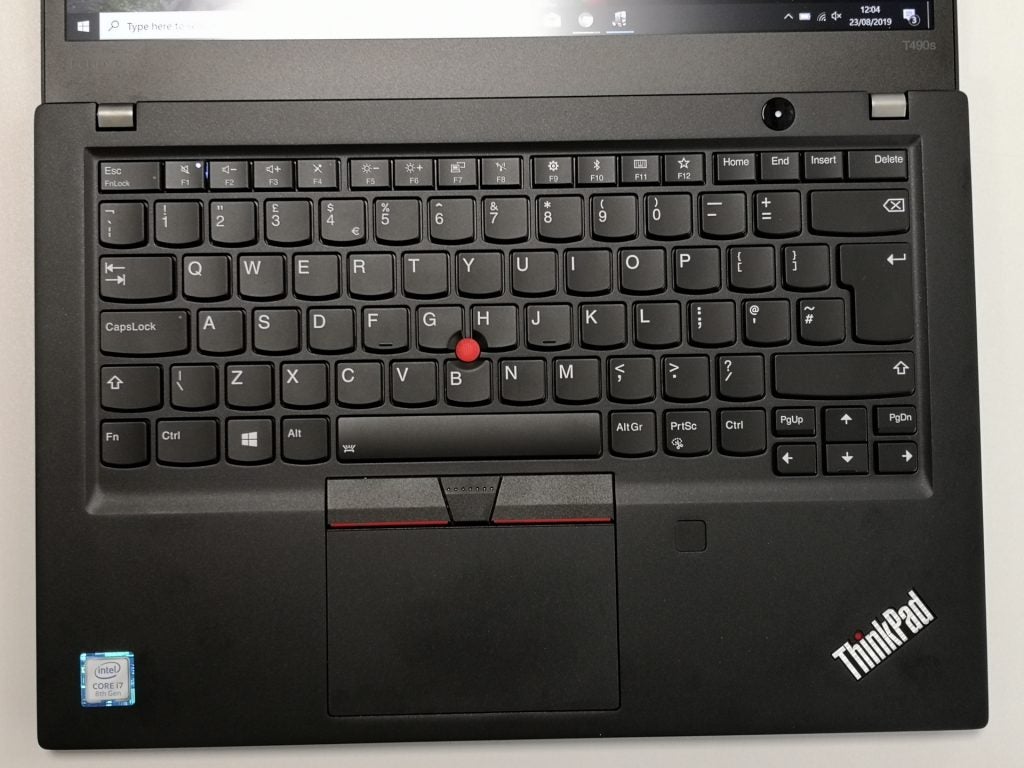
Unlike a lot of chiclet-type keyboards seen on laptops of this size, the ThinkPad T490s keys fire back quickly and boast generous travel
Keyboard – What is the Lenovo ThinkPad T490s keyboard like for working on?
Most notebooks this thin have keys with puddle-shallow travel – or, in the case of the MacBook Air 2018’s butterfly switched keys – basically no travel at all. The Lenovo ThinkPad T490s isn’t most notebooks – the keys here offer 2mm of travel.
While that’s nowhere near as deep as what you’d get on a typical gaming keyboard, compared to most laptop keyboards, the T490s keys feel deeper than the Mariana Trench. The keycaps themselves also feel tough as nails, with not one of them showing off any telltale signs of wobble when I was tapping away at them.
That depth and solidity combined with snappy key switches make for a typing experience that’s unlike anything else I’ve experienced on a laptop for a while. I get the impression that some people will find it difficult to adapt, in the same way that some folk dislike Apple’s butterfly switches – because it’s so different to the norm. For the most part, I loved typing on the ThinkPad T490s.
I liked that the Print Screen button can be found on the bottom row, and holding down the Fn key when you press it sees Snip & Sketch loading up, so you can easily grab a portion of the screen. It’s similar to pressing Cmd + Shift + 4 on a MacBook. I also like that you can toggle the keyboard’s underlight by pressing Fn + Space Bar.
There are a few things by which I was less enamoured. The positioning of some of the keys felt a little off in places – particularly the Function (Fn) key, which sits in the bottom left corner; it’s where you’d normally expect to find the Control (Ctrl) key.
Initially, I’d find myself attempting to copy and paste text from Google Docs to the Trusted CMS, wondering why there was nothing in the clipboard. Turns out I was pressing Fn + C instead of Ctrl + C.
Muscle memory is partially to blame here. I’m sure you’ll get used to the set up as I soon did. I’m less forgiving about the tiny, Hobbit-sized arrow keys and the fact that they’re bunched into the bottom-right corner along with the Page Up and Page Down keys, however. The other navigation keys (Home and End) are similarly squashed, and have been relegated to the top right.
ThinkPad fans will be quick to point out that this has been the case for years, and if you don’t like it then tough. Not everyone is a diehard ThinkPad fan, so perhaps some keyboard feng shui is in order here for future versions.
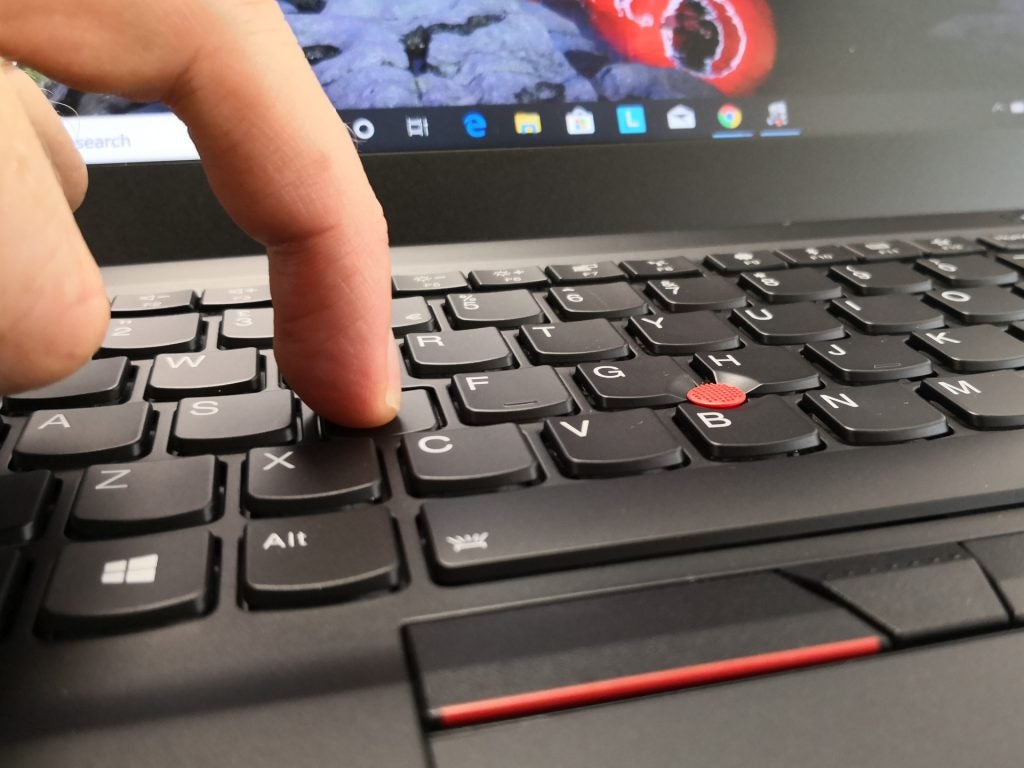
Despite a few odd layout choices, the ThinkPad T490s’s keyboard is one of the best I’ve used
Likewise, I just can’t get on with the nub; personally, I subscribe to the LinusTechTips philosophy in this regard. I understand that some people love the pointing stick, but I’m not one of them. In truth, though, I made only a couple of typos on account of the nub at the centre of the deck.
While I wasn’t too keen on the pointing stick, the trackpad is super-responsive. By default, it’s sensitive enough to be able to have the cursor whip from one side of the screen to the other with just a gentle flick, which compensates for its relatively small size.
North of this is not one, not two, but three buttons – left, middle, and right-click. Left and right-click do what you’d expect. If you’re not familiar with three-button pointers on Windows, most useful is the middle-click function on web browsers.
Clicking on any non-hyperlinked area of a web page will see the mouse cursor turn into a directional control, which will allow you to scroll through large pages with greater ease.
Also, if you hover over back, forward, or refresh, and click with the middle button instead of navigating away from or refreshing that page, your browser will open a new tab and the URL you’d otherwise have moved to (or refreshed) will appear in that new tab instead.
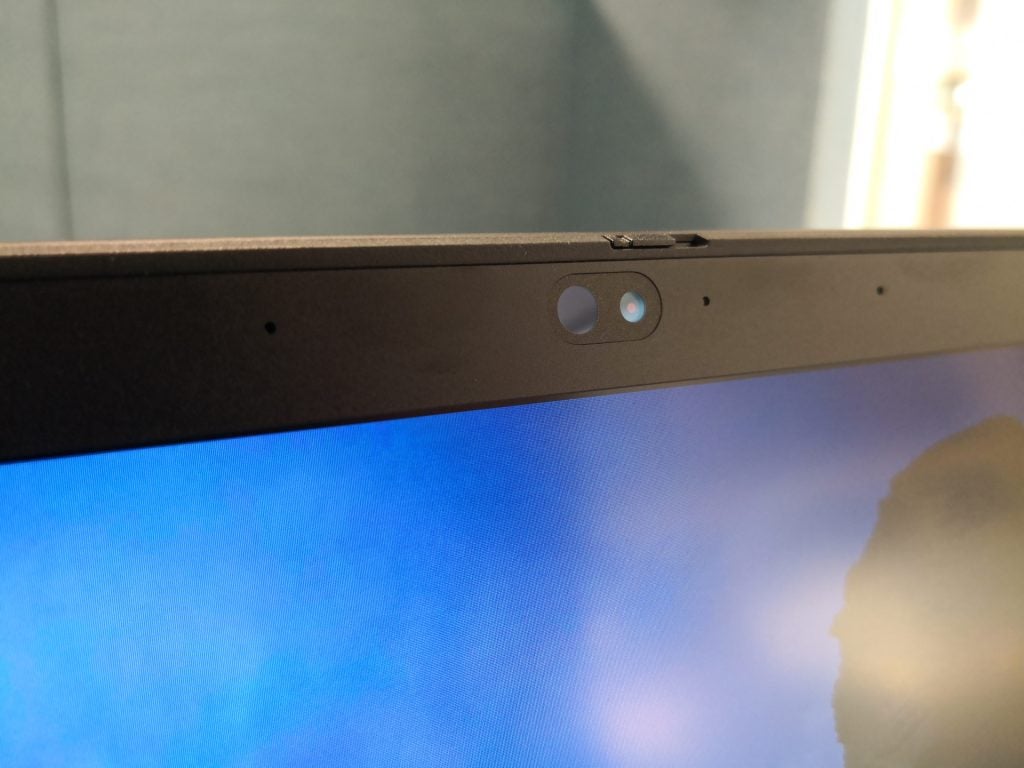
Not using the webcam but would rather not have a piece of tape over the lens? Lenovo’s literally got you covered
Display – Is the Lenovo ThinkPad T490s OK for photo work?
The Lenovo ThinkPad T490s display is very good, and yes, it should cope fine with basic photo work. The display offers high levels of colour space coverage, good contrast, punchy levels of brightness – all of which, combined with the anti-glare coating, ensured superb visibility in a variety of working environments.
I was even able to complete a few paragraphs of this review outside recently, returning indoors to finish off not because of poor visibility but because it was just too hot.
I recorded maximum brightness levels of 396.16 nits, which is decent, far above the 300-nit level you should expect from a premium laptop. A black level of 0.3 nits is also fine, if not quite great. In an ideal world, every display would have a black level of zero – in other words, every black pixel on a panel would be totally black – but, realistically, you’re not going to get that unless your laptop has an OLED screen, and those are expensive.
Still, these two scores add up to a high contrast ratio (1290:1). The difference between the brightest and lowest points on the display mean that photos, videos, and web pages will look richer and pop out more than they would on a less bright display. I especially liked how crisp, inky, and defined black text would look on the white background of a document.
Despite getting a colour temperature reading of 7476K, above the 6500K natural white light temperature, nothing looked especially cold or bluish to my eyes. That said, you might want to crank up the Night Light setting a little if you’re worried about eye strain, especially if you’re working late.
The model I tested featured the standard IPS (in-plane switching) display, which offered good viewing angles. Sometimes, laptops with anti-glare coatings don’t offer the best viewing angles, but on the ThinkPad T490s, two people can comfortably watch streamed content together.
The ThinkPad T490s’s display isn’t quite best-in-class – no laptop I’ve tested has been able to beat the MacBook Pro 2018 in terms of colour gamut coverage or overall quality – but it’s up there with the best. Below are the results recorded on running the standard Trusted Reviews laptop display test using DisplayCAL 3 and an X-Rite i1 Display Pro colorimeter, against competing laptops:
| sRGB | Adobe RGB | DCI-P3 | |
| Lenovo ThinkPad T490s | 94.1% | 66.2% | 68.2% |
| HP EliteBook 1050 G1 | 91.4% | 65.3% | 68% |
| Dell XPS 13 (2019) | 98% | 69% | 71% |
| Apple MacBook Pro 2018 13-inch | 100% | 84% | 98.9% |
As you can see, the T490s is roughly on par with the HP EliteBook 1050 G1 ( aimed at business users) colour space-wise, but a little below what you can get with the new Dell XPS 13 and, as I said before, the MacBook Pro 2018.
As such websites, digital art, and most digital photos (those shot in the sRGB space, anyway) will more or less look as they should on the Lenovo ThinkPad T490s.
While you wouldn’t want to do any intensive photo editing on this laptop (for that you’d need a device with a dedicated graphics card – the ThinkPad T490s just uses the processor’s built-in UHD Graphics 620), tweaking your holiday snaps shouldn’t prove a problem.
The low Adobe and DCI-P3 scores mean that this isn’t the laptop for you if you want to seriously get into digital photography (some prefer the wider and more ‘natural’ colours achieved when shooting in Adobe); videographers will want to work in the DCI-P3 space.
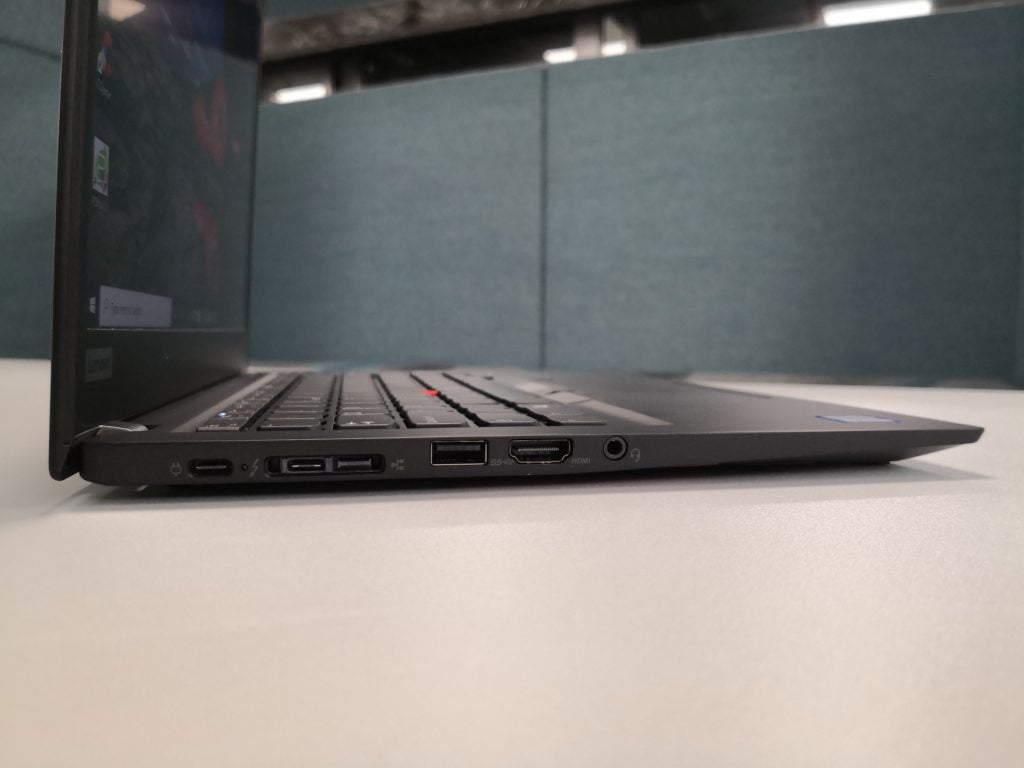
If you want to make use of the Ethernet port here, you’ll need to cough up extra for an adapter (left-hand ports L-R: USB-C, USB-C with Thunderbolt 3, Ethernet, USB-A, HDMI 1.4, 3.5mm audio jack)
Performance – The Lenovo ThinkPad T490s is smoother than a 20-year-old Whiskey (Lake)
The model I tested featured an Intel Core i7-8565U Whiskey Lake processor and 16GB of RAM. That’s more than enough processing power and memory for office applications. Considering you’re not going to be playing triple-A games on this, or editing video, you’re well equipped to tear through your daily to-do lists on the ThinkPad T490s.
I ran the usual suite of Trusted Reviews benchmarks to see how the ThinkPad compares to similar systems.
Not surprisingly, performance here is similar to what I’ve seen on laptops such as the Asus ZenBook 15 (UX533F), and Asus ZenBook Pro 14 (UX480), and what my colleague Ryan Jones saw with the Dell XPS 13 and Razer Blade Stealth – all of which feature the same processor – and the HP EliteBook 1050 G1.
PCMark 10, which simulates a range of office tasks, output a score of 4000. That’s a little under the 4500 that PCMark 10 developer UL says indicates a laptop that’s suitable for office use and light PC work. That’s a similar score to what we’ve recorded with other Whiskey Lake laptops, and none of those have been slouches performance-wise.
The results from running Geekbench 4 – a CPU stress-test – were also broadly similar. The Lenovo ThinkPad T490s gave me single-core and multi-core scores of 4647 and 13,742 respectively.
This is in a similar ballpark to the Dell XPS 13 (4877, 14,509) but not quite as good as the Asus ZenBook 15 (5166, 17,378). The T490s didn’t score as well here as the HP EliteBook 1050 G1. This isn’t surprising, given that the model I tested ran on a high-performance Core i7-8850H Coffee Lake processor.
Despite these respectable but perhaps not class-leading scores, I found that day-to-day the ThinkPad T490s was a dream to work on.
The SSD, a 512GB Intel Pro 7600p (477GB user available) also delivered super-fast read and fast-ish write speeds of 3145.20MB/s and 1570.80MB/s when I ran the CrystalDiskMark benchmark.
This means that not only will saving any work to the hard drive will be a quick, near-instant process (unless you’re saving hundreds of photo files), but general operations will be silky-smooth.
Battery – Will the Lenovo ThinkPad T490s last all day?
Easily. Expect to get around 10 hours out of a full tank on the ThinkPad T490s. Running the PCMark 8 “Work” benchmark, which runs a loop of simulations of every day office tasks, from video calling to word processing to web browsing, until the battery reaches critical levels, I managed 9hrs 8mins with the display’s brightness locked at 150 nits.
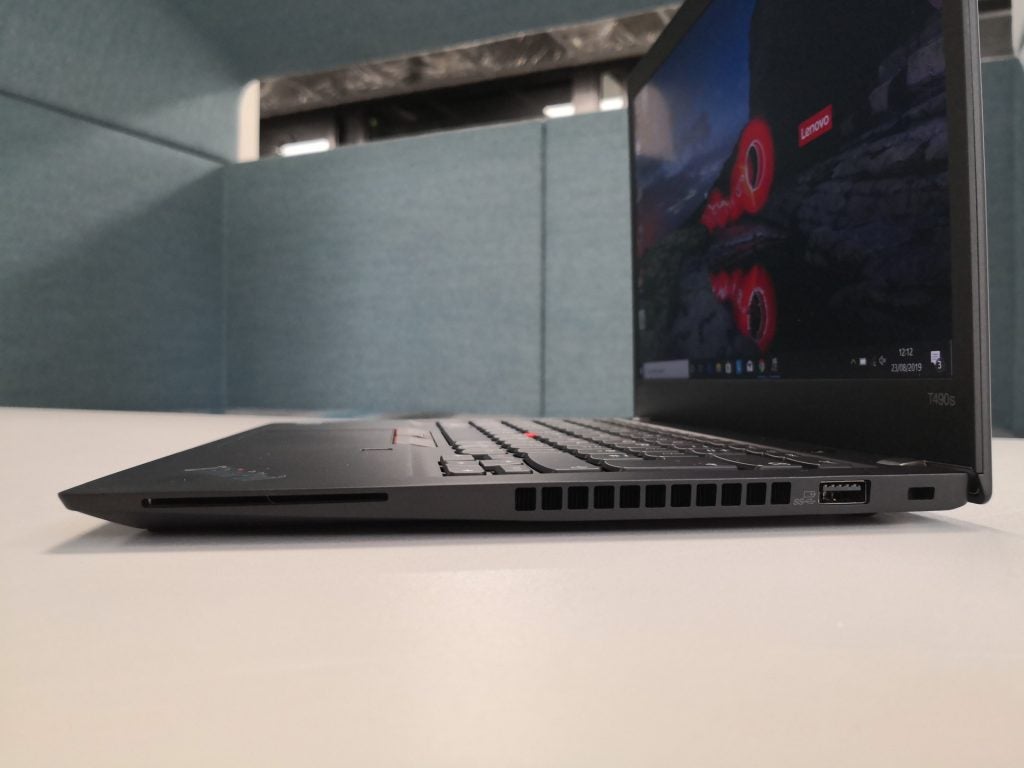
Ports on the right-hand side: Lenovo smart card port, USB-A, Kensington lock slot
Note that PCMark 8 tends to understate laptop battery performance, and if you dip the brightness further, you can squeeze a bit more power out of the T490s.
One of the touted benefits of the Whiskey Lake line of chips is advanced power management, and many of the laptops I’ve tested with the same processor offer around 8-10 hours of juice – sometimes a bit more. As such, the Lenovo Thinkpad T490s is fairly typical in this regard.
Charging up the ThinkPad from empty takes just over two hours. After half an hour on the mains, you’ll have around 40-45% power, and over 75% after an hour.
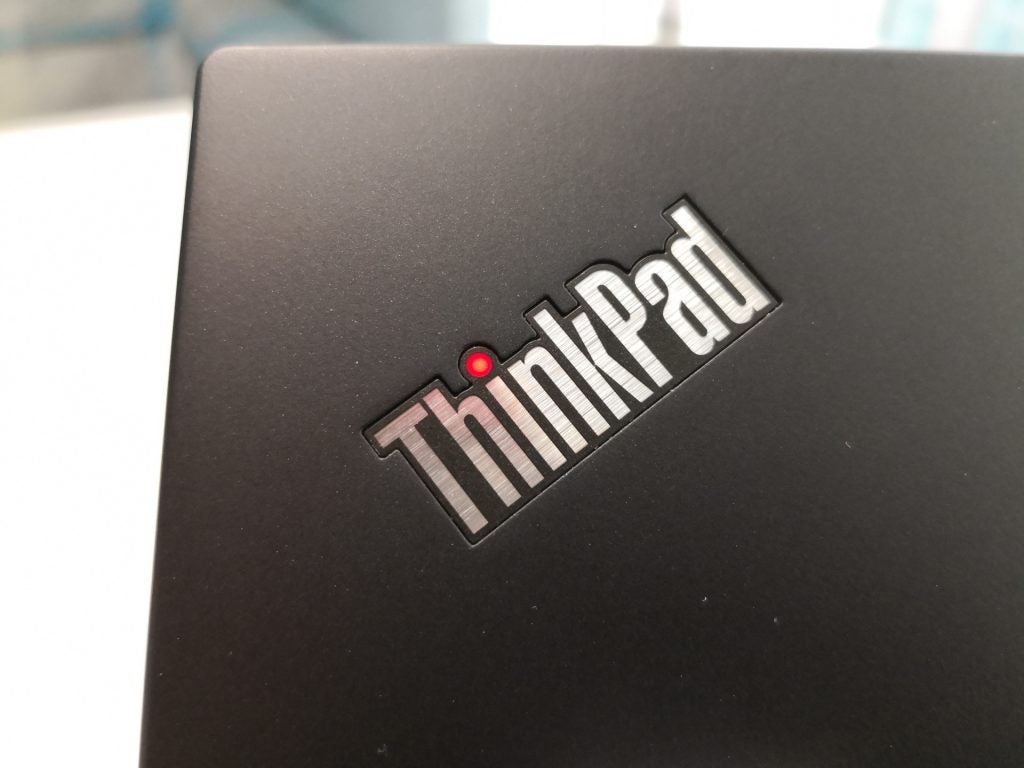
“I’m sorry, Dave, I’m afraid I can’t do that”
Price – How much are the new Lenovo ThinkPads?
If you’re buying directly from Lenovo’s site, you can change the individual components – the processor, the display, and the amount of RAM, for example.
Here are the specs and prices of the two standard configurations you’re likely to find online, as well as indicative prices for components should you wish to build your own custom version.
| Display | 14-inch Full HD, 250 nits max brightness | 14-inch Full HD, anti-glare coating, 400 nits max brightness |
| Processor | Intel Core i5-8265U (1.60GHz, boost up to 3.90GHz, 4 cores, 6MB cache) | Intel Core i7-8565U (1.40GHz, boost up to 4.60GHz, 4 cores, 8MB cache) |
| Graphics | UHD Graphics 620 | UHD Graphics 620 |
| Memory | 8GB DDR4 2400MHz | 8GB DDR4 2400MHz |
| Storage | 256GB SSD | 256GB SSD |
| Price | £1159.99 | £1279.99 |
Note that the standard Lenovo ThinkPad T490s option includes a Core i5-8265U processor, 8GB of RAM, a 128GB SSD, and a 14-inch Full HD IPS display.
- Intel Core i7-8565U processor: £96
- Intel Core i5-8365U processor: £99.60
- Intel Core i7-8665U processor: £301.20
- 16GB 2400MHz DDR4 RAM (memory): £96
- 256GB SSD M.2 2280 NVMe (storage): £27.60
- 512GB SSD M.2 2280 NVMe (storage): £178.80
- 1TB SSD M.2 2280 NVMe (storage): £364.80
- 400-nit anti-glare display: £66
- 300-nit anti-glare, multi-touch display: £66
Editor’s Note – The price for the Privacy Guard screen option wasn’t available at the time of writing.
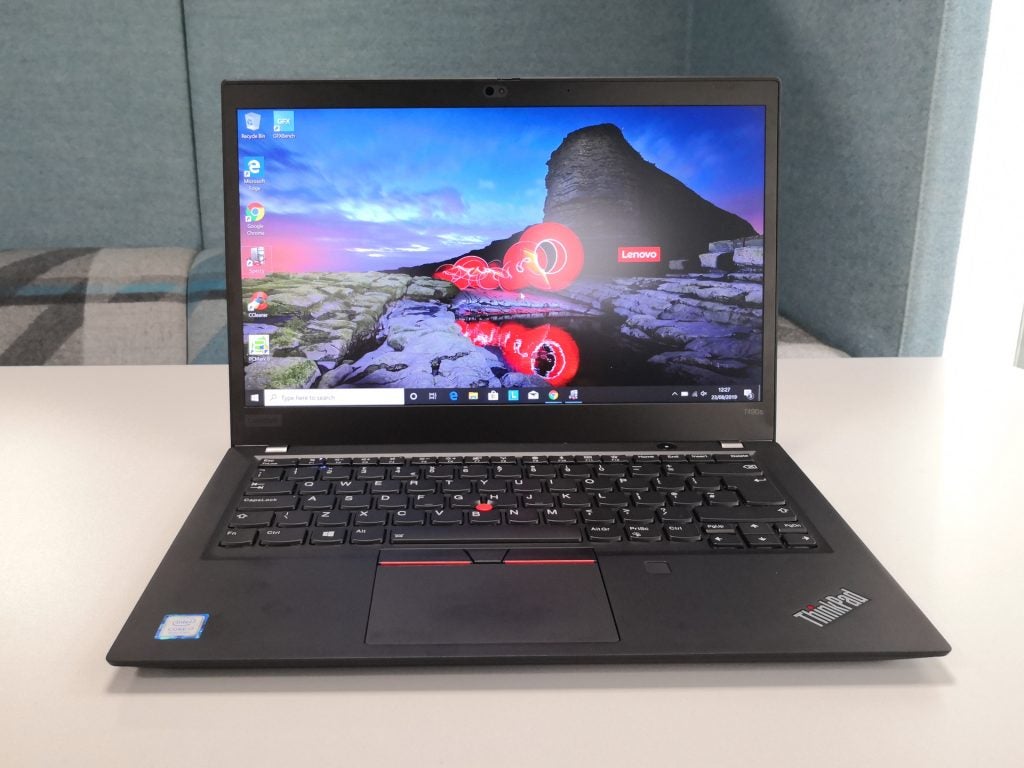
Should I buy the Lenovo ThinkPad T490s?
In case the ThinkPad pedigree isn’t speaking for itself, reasons for buying a new Lenovo T490s are as follows: it’s an un-flashy but versatile laptop that’s a pleasure to use, and it comes with sufficient security features included to keep your IT department happy.
Whether or not you’re working in a corporate environment, freelancers of all stripes after a reliable Windows 10 laptop will likely appreciate this utilitarian packhorse. While the ThinkPad T490s might be priced too highly for some students – the range starts at £1399.99 – I can see this appealing to anyone about to start a BA or BSc, especially if they need a reliable and hard-wearing device that will see them through the years.
Style-wise, the T490s isn’t the most stylish of laptops out there, although its bare-bones anti-aesthetic is part of the ThinkPad charm. If looks are just, if not more, important to you as performance, then you could pick up the Asus ZenBook 15. The HP EliteBook 1050 G1 remains a great choice for business users, too, and comes with a privacy screen feature for no extra cost.
Verdict
The Lenovo ThinkPad T490s means business. Look beyond the defiantly anachronistic stylings and you’ll find a solid, reliable machine that offers a level of security beyond what most other consumer-grade devices can offer.
A capable, powerful, and smart – if retro-looking – Windows 10 laptop.
How we test laptops
Unlike other sites, we test every laptop we review thoroughly over an extended period of time. We use industry standard tests to compare features properly. We’ll always tell you what we find. We never, ever, accept money to review a product.


